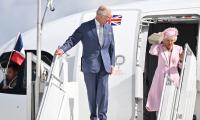One must shake one’s head in exasperation at the ad-hoc way decisions are made in Pakistan in relation to the Covid-19 pandemic.
By waiting two weeks after lifting the lockdown, the federal government’s decision to make face masks in public spaces mandatory is an example par excellence of locking the stable door after the horses have bolted.
Unfortunately, the value of using a face mask to cover the nose and mouth was not appreciated early on, least of all by Prime Minister Imran Khan who could have set a good example by wearing a mask in public appearances. He could have looked at the experience of countries like China and Singapore to understand why face masks are essential.
It is ironic to see pictures of businesspeople who should have known better sitting cheek by jowl in their trade associations’ meetings to discuss the negative impact on their businesses from the lockdown while themselves contributing to the reasons for the lockdown.
Here the World Health Organization (WHO) must share the blame for not advocating this low-cost interventionist measure along with the other measures they recommended such as social distancing and frequent handwashing to contain the spread of Covid-19. Why the WHO did not initially favour the use of masks is perplexing since they had witnessed their utility during the SARS and MERS outbreaks that are both caused by a species of the coronavirus. (The WHO has only last week endorsed the use of masks).
With little or no running water in many Pakistani homes and large families living chock-a-block, hand-washing and social distancing are unlikely to be observed as a prophylactic measure except by the upper-middle and upper-income groups. However, facial coverings are an easily usable and effective option that could have saved lives and needless suffering had their use been mandated from the start.
Masks are not necessarily expensive. They can be made at home in a few minutes by using a bandana as demonstrated on television by CNN’s resident medical expert Dr Sanjay Gupta. This video could have been the basis for similar demonstrations by local experts and shown on television but the initiative was not taken.
In Tanzania masks are being made from polypropylene sacks normally used to bag corn flour, a food staple there. With its large textile sector, Pakistan’s garment manufacturers could easily have been tasked to produce masks on a large scale with the federal and provincial governments being their major customers and with the export market as an added incentive.
Masks are not a complete solution but there is strong evidence in their favour. Thus a recently concluded meta-analysis published in ‘Lancet’ finds that mask usage reduces the probability of getting Covid-19 from 17.4 percent to 3.1percent.(https://www.thelancet.com/journals/lancet/article/PIIS0140-6736(20)31142-9/fulltext)
The next big wave of infections in a week or two is all but guaranteed since public transport has been allowed to operate within cities. Granted passengers on buses are required to wear masks but since they are practically hugging each other (unsurprising given the shortage of buses in relation to the number of prospective passengers in major cities) this only defeats the purpose of a Covid-19 mitigation strategy.
Why is public transport so fraught with risk? Because of the presence of ‘superspreaders’. These have been defined by epidemiologists as persons each of whom can infect at least eight other persons with the disease. Superspreaders may well be symptom-free but their footprints are epic.
Writing in the New York Times epidemiologists, Dillon Adam and Benjamin Cowling point to the study they conducted of 1038 cases of Covid-19 in Hong Kong between January and April of this year in which they found that “just 20 percent of cases, all of them involving social gatherings, accounted for an astonishing 80 percent of transmissions”. The researchers also reached the startling conclusion that 70 percent of those infected did not infect anyone else.
To understand how to control Covid-19, one should look at the value of R (reproduction number) which represents the average number of cases a typical infectious agent could spread the disease to. Ebola has an R of 2 meaning each person suffering from Ebola spreads the disease on average to 2 other persons. For measles R is anywhere from 12 to 18 which explains why a measles outbreak spreads like wildfire.
The R value for Covid-19 is estimated to be between 2 and 3 (strictly, this is the value of R naught which is the R number when there is no immunity in the population and before social distancing measures are adopted).
Superspreaders are a key reason why we need a system of widespread testing. Currently (June 5), the number of tests carried out in Pakistan’s is among the lowest in the world at 2.9 tests per 1000 persons. This is lower on a per capita basis than India’s which has conducted 3.2 tests per 1000 persons but higher than Bangladesh which has conducted even fewer tests at 2.2 tests per 1000 population. Unsurprisingly, all three countries are struggling mightily with Covid-19 and the number of new infections is rising daily.
The cut-off point for a contagion to spread or decline is an R value of one (1). If R is greater than one then the number of infections will increase exponentially in the population; conversely if R is less than one then the number of infections will taper off so that the outbreak gradually dies out over time.
According to Adam Kucharski, an epidemiologist and the author of the book titled ‘The Rules of Contagion’, four things influence R and therefore the intensity of a viral disease. First, how long is the person infectious for? The longer the duration of the person’s illness, the greater the potential for the virus to spread. The second factor is the opportunities for infected agents to spread the virus. The third is the probability of transmission. Finally, the susceptibility of the population to the virus.
These four factors are represented by Kucharski in the ‘DOTS’ framework where D stands for duration of the disease, O for Opportunities for transmission, T for Transmission probability and S for susceptibility of the population to the disease. R is a number derived when these four factors are multiplied together.
The major implication of Kucharski’s approach is that to reduce R we need to operate on any or all of the four factors. For instance, opportunities for transmission (O) can be curtailed through lockdowns and quarantines.
It is easy to slam the government’s decision to lift the lockdown. But the situation presents a moral dilemma which would rest heavy on the shoulders of any prime minister, especially Imran Khan who aspires to create a welfare state.
It is therefore easy to assail the government’s decision to relax the lockdown from the vantage point of a person living in a big bungalow in an affluent urban neighbourhood with ample foreign currency savings stashed abroad. For this person, the lockdown is at most an irritant. But for the vast majority of the people in this country living daily from hand to mouth the lockdown has deadly consequences.
So, on the one hand there is a significant probability of contracting Covid-19 and dying if you venture out on public transport to your place of work. But on the other hand there is a certainty that you and your family would slowly starve to death with the complete loss of income. In this situation which of the two choices should one opt for?
The writer is a group director at the Jang Group.
Email: iqbal.hussain@ janggroup.com.pk
The cases of Attabad Lake and Gwadar simply highlight the many tragedies that exist around the country
Reaffirming loyalty to democracy as a problem solver can be a good starting point
Unfortunately, Pakistani films and TV dramas have seldom ventured beyond domestic intrigues and love triangles
A woman walks past a building of the International Monetary Fund. — AFP/FileThe annual and spring meetings of the...
Late Benazir Bhutto's daughter Asifa Bhutto Zardari addresses the Christian community in Bihar Colony on January 23,...







